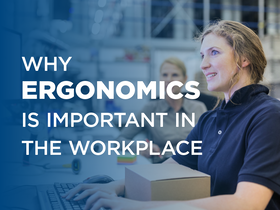- Home
- Loss Control
- Loss Control Insights
- Why Ergonomics is Important in the Workplace
Ergonomics is one of the most common workplace safety concerns. Workplace injuries, such as repetitive strain injuries, back pain and eye strain, can result from poor ergonomics. These problems can lead to reduced productivity, absenteeism and long-term disability. Understanding ergonomic processes and hazards can help you provide workers with a safe and healthy workplace.
What is Ergonomics
Ergonomics is the study of people’s efficiency in their working environment. It refers to how workers interact with their surroundings during the workday, including posture and movements. There are four primary workplace situations where ergonomics applies:
- Objects handled by workers
- How workers move objects
- Processes or functions performed
- Work area arrangement
Ergonomics is about designing for people so that workplaces, products and systems fit the individuals who use them.
3 Types of Ergonomics
There are three types of ergonomics: physical, cognitive and organizational. Each affects how people interact with their environment and contributes to worker effectiveness. It also impacts worker satisfaction, organizational success and the bottom line.
- Physical Ergonomics—This refers to the physical load on the human body when performing activities. Without physical ergonomic safety measures, workers can develop musculoskeletal disorders (MSDs), which affect the muscles, nerves, blood vessels, ligaments and tendons. Awkward body positioning, reaching overhead, and consistently repeating similar tasks are a few of the activities that OSHA identifies as causes of MSDs.
Check out EMC’s Workplace Injury Prevention Guide for more information on common workplace injuries and best practices to help minimize risk.
- Cognitive Ergonomics—Perception, memory, reasoning and motor response affect how someone interacts with and performs their work. Cognitive ergonomics designs and arranges information and data to create a lighter cognitive load.
For Example: Providing work instructions on paper increases cognitive workload, requiring memorization and focus. A worker is required to look from the paper to their work and connect the written steps to the movement needed.Instead, break steps down into digestible bits of information and overlay the instruction steps onto the equipment, requiring no memorization. This way, work instructions can direct workers to the exact needs of the task (say, aligning a part to a precise position). Finally, use image depiction of the step where possible; visual instructions help workers with cognitive disabilities engage with their work more easily.
- Organizational Ergonomics—This type of ergonomics combines the knowledge of physical and cognitive ergonomics to optimize safety and efficiency across the entire organization. This includes finding ways to maximize teamwork, improve communications, increase output and support the overall quality of a product. Examples of organizational ergonomics can seen in standardized training, unified data storage through the cloud and lean manufacturing techniques.
What is an Ergonomic Hazard?
An ergonomic hazard refers to any physical condition or factor found in the workplace that can cause injury or health concerns in the short or long term. The main areas of concern for ergonomics hazards include:
- Equipment layout and operation
- Lifting, pushing and pulling
- Lighting
- Noise
- Systems and computer programs
- Task, job and workplace design
- Workstation design and height
Here are five tips for preventing ergonomic hazards, including workplace improvements, modifying repetitive tasks and tips for properly lifting heavy objects.
Types of Ergonomic Injuries
Ergonomic injuries are caused by factors stemming from an individual’s body mechanics, posture and muscle exertions in relationship to their workspace and equipment. A workspace can be anything from a manufacturing floor, home office or care center. Ergonomic injuries and musculoskeletal disorders(MSDs) take many forms, but some occur more commonly, especially among industrial and manufacturing employees.
- Lower back pain—Occurs because of excessive exertion, poor mechanics, fatigue and equipment that doesn’t fit the worker’s body.
- Carpal tunnel syndrome—Occurs when the muscles and tendons in the wrist are inflamed from overuse and poor mechanics, causing them to swell and put pressure on the median nerve. This can cause the worker to experience tingling or numbness in the fingers and hand, which can progress to pain and weakness in those muscles.
- Neck and shoulder injuries—Neck injuries stem from many factors, including long periods spent looking up or down or poor posture while working. Likewise, shoulder injuries can occur when an employee is required to lift a heavy weight above their head or hold one or both arms above the head for long periods.
- Tendinitis—A broad term that describes inflammation of the tendons, which can cause significant pain and make work impossible. It’s most common in employees whose jobs require substantial physical exertion.
- Tennis elbow—Refers to pain or inflammation that occurs where the outer forearm connects to the elbow joint. It primarily affects employees in industries requiring physical exertion and usually occurs in the employee’s dominant arm.
Conclusion
Invest in proactive safety measures that include a strong focus on ergonomics to help keep workers safe in the workplace. Proper body mechanics and good posture are some of the best tools you can give your employees. Just as important as the work environment, ergonomic evaluations can reveal ergonomic risks and hazards before they cause claims. Check out EMC’s ergonomic Safety Program Templates to start improving ergonomics in your workplace.
Get in touch
Need help? We’re here for you! Whether you have questions or need personalized assistance, your local office is ready to support you.
Loss Control Insights
Stay informed with the latest news and receive actionable safety tips, all carefully curated by our team of experts.
